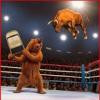Fiat money history...
#1

Posted 10 February 2007 - 04:24 AM
By Robert Morley February 2007
History is littered with the wrecks of paper money adventures. In hundreds of cases, in all lands, at all times, the story has been the same: loss of confidence in and eroding value of fiat currencies. Paper money does not work; the temptation of the printing press is too great. Emperors, kings, presidents, prime ministers and central bankers have not been able to resist the temptation: When faced with economic problems or overspending, they have all chosen to create the money needed to pay bills or fight wars.
The world’s first known experiment with fiat money (paper money not backed by tangible assets like silver or gold) was in 10th-century China. At first successful, it was abandoned a few hundred years later because it, like all the paper currencies that followed, was found to be too susceptible to inflation. But, to China’s credit, a few hundred years is actually pretty successful as far as paper money goes.
By 1200, the Chinese had forgotten this earlier failure and launched another paper money scheme, this time under Kublai Khan. Marco Polo was so impressed, he reported that Kublai Khan “had the secret of alchemy in perfection” and that he “causes each year to be made such a vast quantity of money that it must equal in quantity all the treasure of the world.” But Marco Polo visited Kahn’s empire during a time that American historian Alexander Del Mar called “the most brilliant period in the history of China”—which, it turns out, was just before its collapse. “Kublai Khan entered upon a series of internal improvements and civil reforms, which raised the country he had conquered to the highest rank of civilization, power and progress. … Population and trade had greatly increased, but the emissions of paper notes outran both, and the inevitable consequence was depreciation. … Excessive and too rapid augmentation of the currency resulted in the entire subversion of the old order of society. The best families in the empire were ruined” (Bullion Vault, Oct. 27, 2006).
Fiat currency adventures in Europe also have a history of painful failures. For hundreds of years, the Roman Empire reigned, increasing in power and influence. Even when Nero decided to start debasing the currency by taking the silver out of the coins, Rome prospered for a while. However, as Rome decayed, successive emperors continued to remove the silver content of the denarius to pay the bills. Early in the first century, the denarius had been essentially pure silver. By the time of Nero, in A.D. 54, the silver content of the denarius had slipped to 94 percent; by A.D. 68, it had fallen to 81 percent; by A.D. 218, only 43 percent was silver. In A.D. 244, Philip had the silver content reduced to 0.5 percent. At the time of Rome’s fall, the silver content of the denarius was 0.02 percent and pretty much everyone was refusing to accept it as payment for anything (LewRockwell.com, Nov. 4, 2006).
But central banks and governments are poor students even of more recent history.
During the 1700s, France stands out as a paper-currency basket case. John Law first established a paper currency in France in 1716. Backed by King Louis XV, who declared all taxes had to be paid with paper dollars, it gained wide acceptance—more so than coinage, in fact. But as with all paper currencies, excessive printing, additional moneymaking schemes (e.g. the Mississippi bubble), and fraud eventually blew up the system, wiping out many people’s investments and savings.
During the late 18th century, a new French government again adopted fiat currency, which was called the “assignat.” But again, money-creating destroyed it: By 1795 inflation had reached 13,000 percent. Napoleon replaced the assignat with the gold franc, inflation subsided, and a century of relative economic stability resulted. In the 1930s, the French again adopted a paper franc. In 12 years, its currency lost 99 percent of its value.
Weimar Germany is another example of a failed currency. At the end of World War I, Germany decided to print the money needed to pay the debts it owed foreign nations. By the time the government was done printing money, the currency had been so debased that postage stamps cost millions of deutsche marks.
In 1932, before adopting a paper currency, Argentina was the eighth-largest economy in the world. Since abolishing their precious-metal-backed currency, Argentineans have been plagued with continual currency inflation—even hyperinflation reminiscent of Weimar Germany. The latest bout was in 2001, when the peso lost 75 percent of its value in one year.
Each couple of years it seems like another nation’s fiat currency falls apart. In 1992, Finland, Italy, Norway and other European countries suffered when their currencies devalued. In 1994, it was the Mexican peso “tequila hangover” crisis, which spread through several Latin American nations including Brazil, Venezuela and Argentina. 1997 was the year of the “Asian flu” contagion, which started with the Thai baht and then within days spread to Malaysia, the Philippines, Indonesia, Hong Kong and South Korea. The currency collapses associated with “bahtulism” were still destabilizing other currencies in 1999. 1998 saw the Russian ruble fall apart and experience massive devaluations. In February 2001, the Turkish lira lost 40 percent of its value in one day.
To attempt to chronicle the massive currency devaluations that are endemic to many African nations would require stacks of paper, but Zimbabwe is too clear cut of an example to pass up. Formerly known as Rhodesia, Zimbabwe was one of the wealthiest countries in Africa. In fact, at the time of its independence in 1980, the Zimbabwe dollar was worth more than the U.S. dollar. Then along came President Robert Mugabe, who decided to seize virtually all property owned by white citizens to give to black citizens. The upheaval within society caused an economic collapse. With a non-functioning economy and falling tax revenues, Mugabe decided to just print up the money needed to pay the bills, destroying Zimbabwe’s currency and any of his people’s savings in the process. As of May 2006, it cost $416 Zimbabwe dollars to purchase a single two-ply square of toilet paper, while a whole roll cost $145,750.
Why should we think America is somehow special and immune to currency crisis? Go back and study history. In addition to the fact that the U.S. dollar has lost 92 percent of its purchasing power since 1913—41 percent in the 1934 revaluation alone—there were times previously when the dollar lost even more value.
Maybe you have heard the expression “not worth a continental.” That expression developed in regard to America’s paper money during the Revolutionary War era (not Ford’s Lincoln Continental luxury vehicle). Congress printed contintentals to pay for the war, but the currency, having no backing, soon lost its value.
The U.S. government again tried a paper currency experiment during the Civil War. The Legal Tender Act of 1862 allowed the Lincoln administration to issue paper money backed by nothing but the government’s decree that it be accepted for trade. The paper money lost value so quickly that the practice of fiat currency in America fell out of favor until the Federal Reserve System was put in place in 1913. Paper money in the South by the end of the Civil War was worth even less.
The sad part is that when governments resort to mass currency creation, it is the common person’s savings that get destroyed. The interest earned in savings accounts never keeps up with mass-printing-induced inflation.
For the U.S. dollar, its final link to a hard, tangible asset was severed 35 years ago. Today, the majority of dollars are little more than bits of electronic information zooming between banks and corporations that people don’t even see, and which they need computers with super calculators to keep track of. How much confidence is left in the inflated U.S. dollar—a dollar whose value remains high not for any tangible reason, but only because so far America’s trade partners are still willing to accept it?
In Weimar Germany, when the mark was inflated into practical worthlessness, at least the German people were left with tinder and toilet paper. When the dollar collapses and no one wants it, most of it will probably just be deleted.
---------------------------------------------------------
Why the U.S. Dollar Constantly Loses Value
By Robert Morley February 2007
Your wealth is steadily evaporating. Why doesn’t a dollar stretch like it used to?
Ever wonder why your dollar doesn’t seem to stretch as far as it used to? There is a simple explanation: It’s worth less. The reason? The nation’s money supply is constantly being expanded.
Between 1783 and 1913, the U.S. dollar was a real store of wealth. Except during wartime periods, inflation within the United States was essentially zero. If you saved one dollar in 1800, a hundred years later you could still purchase approximately the same amount of goods with your savings.
But in 1913 something changed, and the U.S. dollar started down a long, steady road of devaluations. Using the U.S. government’s own figures, to obtain the same amount of purchasing power of $100 in 1913, you would need over $2,000 today.
In 1970, at the age of 77, Herbert W. Armstrong wrote about how as a boy his mother had asked him to “[g]o to the meat shop and get a dime’s worth of round steak. And tell the butcher to put in plenty of suet.” A “dime’s worth” meant each person in his family received a modest-sized piece of meat, plus plenty of gravy for the potatoes.
In times past, the dollar certainly stretched further. Mr. Armstrong quoted the Labor Department’s figures for how much $5 would have purchased in 1913: 15 pounds of potatoes, 10 pounds of flour, 5 pounds of sugar, 5 pounds of chuck roast, 3 pounds of round steak, 3 pounds of rice, 2 pounds each of cheese and bacon, and a pound each of butter and coffee; that money would also get you two loaves of bread, 4 quarts of milk and a dozen eggs. “This would leave you with 2 cents for candy,” he wrote.
Wow. At most grocery stores today, with $5 you would be hard-pressed to buy a pound of round steak and a chocolate bar.
What changed in 1913? That was the year America adopted the Federal Reserve Banking (frb) system and the nation took its first steps toward abolishing the gold standard and replacing it with a banking system that allowed for unlimited paper money to be created.
Creation of the Fiat System
As described by Alan Greenspan in 1966, the new system consisted of “regional Federal Reserve banks nominally owned by private bankers, but in fact government sponsored, controlled and supported. Credit extended by these banks is in practice (though not legally) backed by the taxing power of the federal government. … But now, in addition to gold, credit extended by the Federal Reserve banks (‘paper reserves’) could serve as legal tender to pay depositors.”
In other words, the dollar would only be partially backed by gold, and banks could create money by lending out money secured by credit from the Federal Reserve banks (even though the reserve banks did not necessarily have gold on deposit themselves). Thus the seeds of America’s first fiat (currency not backed by gold) dollar system were sown.
At that time, however, there were still restraints
upon money-supply growth because the dollar was still convertible to gold upon demand. Anyone cashing in paper dollars was still legally entitled to its value in gold, so the money supply did not balloon completely out of control.
Yet by 1934, the paper money supply had expanded faster than the nation’s gold supply, so in order to prevent the nation’s gold supply from being drained, the U.S. decided to devalue the dollar—by 41 percent. Prior to 1934, an ounce of gold could be redeemed for just us$20.67, however after the revision, the U.S. government would only part with an ounce of gold in exchange for $35. In gold terms, anyone who had a U.S. savings account lost 41 percent of its value—overnight.
Even though the 1934 U.S. currency devaluation rocked people’s confidence in the dollar, World War ii thrust the U.S. dollar into a new status: the world’s reserve currency. Toward the end of the war, representatives of most of the world’s leading nations met to create a new international monetary system, later known as the Bretton Woods agreement. At this meeting, the war-torn and virtually bankrupt nations of the world decided that since the U.S. economy had come to dominate the globe, and because it held 80 percent of the world’s gold due to the war, they would tie their currencies to the dollar, which, in turn, could be converted into gold at $35 per ounce.
Yet under the Bretton Woods system there were still limits on how much paper money a country could create. Each country had to police its own currency or be forced into embarrassing devaluations. The U.S. itself was constrained from overprinting money because the dollar remained fully convertible into gold.
However, by 1971, America had again printed vastly more paper money than was backed by precious metal. According to some estimates, so many paper dollars had been created that the nation’s gold supply only backed 22 percent of them. At the same time, French President Charles de Gaulle, recognizing that the dollar was losing value, had been exchanging his nation’s collection of U.S. dollars for American gold reserves. Seeing other nations following suit, U.S. President Richard Nixon closed the gold window in August 1971, no longer allowing foreigners to exchange their U.S. dollars for gold and thus ending the Bretton Woods agreement.
From that point on, America’s dollar became fiat, not backed by tangible assets. As the Federal Reserve bank of Minneapolis says, the U.S. dollar is fiat and is valuable only as long as “[p]eople are willing to accept fiat money in exchange for the goods and services they sell”—and only as long as “they are confident it will be honored when they buy goods and services.”
Since people were already in the habit of accepting paper backed by gold, Americans hardly noticed when the U.S. greenback became backed by nothing more than faith—until it started affecting their pocketbooks. Loss of the dollar’s gold backing resulted in a U.S. dollar sell-off in which foreign nations dumped dollars on the open market. This in turn caused roaring inflation and gold to spike up into the $800-per-ounce range. After the frb jacked interest rates into the high teens, both Americans and foreigners decided they would trust the government and continued using the U.S. dollar.
The U.S. now operates on what many refer to as the Bretton Woods 2 system. Although there is no formal central bank agreement (as was the case with Bretton Woods 1), many countries, especially those in Asia, have more or less informally pegged their currencies to the dollar.
This system is inherently more unstable than the previous precious-metal-based non-fiat system. Since the U.S. dollar is no longer convertible to gold, there is no theoretical limit to how much the U.S. money base can expand—and the U.S. has been taking full advantage of this situation to increase its money supply.
Nevertheless, as one well-known economics saying goes, there’s no such thing as a free lunch. America’s monetary expansion has been a primary driver behind the massive and continual erosion in the U.S. dollar’s purchasing power.
The Dollar’s Decline
During Alan Greenspan’s term at the frb alone, America’s monetary base tripled and more new money came into being than under all previous Fed chairmen combined. As the government has massively increased the money supply—doubling it in the last seven years alone—those dollars have become less valuable.
So many dollars have been created that only the dollar’s status as a reserve currency, along with the kindness of America’s trade partners, has prevented a complete dollar meltdown. Unfortunately, these dollar supports seem to be crumbling.
At one point, 86 percent of the globe’s transactions were denominated in dollars. Whether it was Russians and Saudis selling oil to the world, or Chinese purchasing wheat from Canada, the dollar was the primary means of payment. Thus, foreign nations needed to keep huge dollar reserves on hand. This was a gigantic plus for the dollar. Had foreign nations not needed to increase their holdings of dollars as world trade grew, there would have been a massive wave of homeless dollars roaming the world looking to be spent, and as the supply of dollars increased, the dollar’s value would have plummeted. Instead, over the years, America has been able to get away with creating the money needed to pay its bills and finance an otherwise unaffordable standard of living.
However, the dollar’s status as a reserve currency is now being challenged. In 2005, the percentage of dollar-denominated reserves held by foreign nations was 76 percent. Now, not two years later, it is down to 65 percent. “[T]here is a gentle and osmotic process underway,” says economic analyst Julian D.W. Phillips: “a lessening of the role of the U.S. dollar in the global reserves” (Financial Sense Online, Nov. 6, 2006).
Former Fed Chairman Alan Greenspan is also warning of possible protracted dollar dumping. “We’re beginning to see some move from the dollar to the euro, both from the private sector … but also from monetary authorities and central banks,” he said in October last year.
Although an all-out revolt against the dollar hasn’t yet occurred, clear signals are emerging that the dollar’s role as the world’s reserve currency of choice could be ending. Last year, Russia’s central bank, Sweden’s Riksbank, the Central Bank of the United Arab Emirates, Qatar Central Bank and the Central Bank of Syria all announced intentions to diversify their reserves away from the greenback.
Perhaps more worrisome is the fact that China and other Asian nations also have been hinting at diversifying out of their dollar reserve holdings. Australian Treasurer Peter Costello admonished central bankers in East Asia “to ‘telegraph’ their intentions to diversify out of American investments and ensure an orderly adjustment” (Sydney Morning Herald, Oct. 18, 2006). Over the past several years, central banks in China, Japan, Taiwan, South Korea and Hong Kong have spent hundreds of billions purchasing American government bonds. They have done so to support the dollar and help keep American consumers purchasing Asian-made products. If Mr. Costello is correct, however, “the strategy [has now] changed.” Recent trends suggest Asians are weaning themselves off American consumption. Consumer demand within China and Asia is growing, as is Asian trade with Europe. As the importance of Asian-American trade wanes, the incentive for Asians to support the dollar and to hold on to their massive dollar reserves is waning as well.
America’s Asian creditors are up to their necks in U.S. dollars and may now be reaching the point where they no longer feel it is safe to hold so great a proportion of their foreign currency reserves in the dollar.
“The exchange rate of the U.S. dollar, which is the major reserve currency, is going lower, increasing the depreciation risk for East Asian reserve assets,” warned the People’s Bank of China Deputy Governor Wu Xiaoling in November. The same month, the central bank’s governor, Zhou Xiaochuan, was quoted as saying that China has plans to diversify its assets into “many instruments,” presumably indicating a move away from the dollar (Forbes, Nov. 24, 2006).
This is big news, since China is the second-largest foreign holder of dollars in the world after Japan. China is estimated to hold approximately 70 percent of its $1 trillion of currency reserves in U.S. dollars. It certainly seems that Chinese central-bank officials are following Costello’s advice about being up front when they plan to sell their dollars. The question doesn’t seem to be whether the Asian banks will dump dollars—it is how orderly and significant the dollar devaluation will be.
America’s massive monetary expansion could be about to boomerang on itself, as it did in 1934 and 1971—only this time, the number of dollars involved absolutely dwarfs all previous currency crises. As the U.S. persistently destroys the value of the dollar by overprinting (or, more correctly, over-creating, since most money created is now digital), foreign nations are losing confidence in the dollar and its role as a reserve currency. Foreign central bank sales are the first waves of a coming dollar storm. The more that central banks dump dollars, the greater the loss of investor confidence in the dollar.
As Congressman Ron Paul wrote in Texas Straight Talk, May 15, 2006, “The consequences of a rapidly declining dollar are not yet fully understood by the American public. The long-term significance has not sunk in, but when it does there will be political hell to pay in Washington. Our relative wealth as a nation is measured in dollars, and the steady erosion of the value of those dollars means we will all be poorer in the future.”
As much as the dollar’s value has fallen in the past, Americans must face the reality of far more dramatic drops to come.
#2

Posted 10 February 2007 - 07:16 AM
#3

Posted 10 February 2007 - 10:30 AM
From my point of view, the US economic success has began not in the 1970's as you said (don't you forget how bad the 1970's was?), but rather in mid 1980's when the alternative system - USSR - has collapsed and America has become the only uncontroled (self-controlled) superpower, or so-called "chosen" - in the world.
However, I must admit, you're right ...somewhere. I've read a few years ago that our planet has room (natural resources) for only 1 bln people. I mean a decent live for the "chosen", or so-called "The Golden Billion" theory very popular in early 1970's. The rest, almost 5 bln folks, should be the "slaves" no matter what. Sounds cynical, huh? Anyway... that is why we do have 1 bln people in the so-called democratic countries ("chosen" and their friends), and the rest are in the countries where so-called the democracy can't exist ("evils"). Even if they do have the democracy, that must be another kind of the democracy.
Let's see.... Elected few months ago new president of Iran of course can't be the democratic leader because he was just "elected", not "chosen". Russian president can't be the democrat. He is loved like Jesus by the Russians. He does the best for Russia indeed, trust me. But he is not "chosen". Saudi Royal family is obviously not the democrats, but they're fiends of "chosen". That's okay, even if Saudi Arabia is the pure "tyrany" by Aristotle, and even if the guys in the 9/11 airplanes were all the Saudis. Let me say more. I've been many times in Japan. I've seen many good stuff. I love Japan, but I haven't seen the democracy out there. That's the pure aristocracy by Aristotle. Japan is a friend of "chosen". The same with S. Korea. China has pretty the same system as Japan or S. Korea now, the same influance of the government in the economy, pretty the same political system, but the 1.5 bln Chinese are not "chosen". Yeah, too many democrats can't exist....
I hope I didn't hurt anybody's feeling. That's just a point of my personal view from the both parts of the world where I used to live on "two fronts".
#4

Posted 10 February 2007 - 10:34 AM
The point of the post is that the results of the fiat money system have not been fully played out.It is hard to recognize the economic growth since the 1970's and say that a fiat money system is automatically bad. The U.S. has done better off the gold standard than we ever did on.
Watch the next 20 more years and you may develop the german attitude towards inflation.
Yuri doesn't understand that the 'West' peaked out around 1910 and has been imploding since then; not just America. The Euro is also doomed, but you'll never see a post from Yuri about that.
Defenders of the status quo are always stronger than reformers seeking change,
UNTIL the status quo self-destructs from its own corruption, and the reformers are free to build on its ashes.
#5

Posted 10 February 2007 - 10:45 AM
#6

Posted 10 February 2007 - 11:19 AM
#7

Posted 10 February 2007 - 11:53 AM
#8

Posted 10 February 2007 - 01:00 PM
So before it gets shut down, I'll throw in my two cents worth.
I believe:
All government is just a human experiment, an experiment plagued by the imperfect and ill-equipped.
Even those with the greatest minds and best intentions fall victim to the rule:
"Power corrupts and absolute power corrupts absolutely."
Added to the imperfection of the ruler is the imperfection of the ruled.
Every democracy is doomed to financial failure.
Because that's what the voters will vote for.
Politicians, it turns out, can do very little about the situation, because if they don't give handouts to the electorate, they will be voted out of office. Thus, the people, through their voting decisions, continue to put politicians into office and keep the ones in office that drive our nation even deeper into debt, ultimately leading to a financial crisis unprecedented in the history of the modern world.
"Democracy is the worst form of government except for all those others that have been tried." - Winston Churchill
"The best argument against democracy is a five-minute conversation with the average voter." - Winston Churchill
"The essence of Government is power; and power, lodged as it must be in human hands, will ever be liable to abuse." - James Madison
"Government is an evil; it is only the thoughtlessness and vices of men that make it a necessary evil. When all men are good and wise, government will of itself decay." - Percy Bysshe Shelley
If men were angels, no government would be necessary. - James Madison
Note: We have grown accustomed to hearing that the USA is a democracy; such was never the intent. The form of government entrusted to us by our Founders was a republic, not a democracy. Our Founders had an opportunity to establish a democracy in America and chose not to. In fact, the Founders made clear that we were not, and were never to become, a democracy.
A pure democracy operates by direct majority vote of the people. When an issue is to be decided, the entire population votes on it; the majority wins and rules. A republic differs in that the general population elects representatives who then pass laws to govern the nation. A democracy is the rule by majority feeling (what the Founders described as a "mobocracy"); a republic is rule by law.
A pure democracy is 3 men voting in a darkened alley to rob a man walking by.
The democratic vote (mob rule) is 3 to 1.
As John Adams explained:
"Democracy will soon degenerate into an anarchy; such an anarchy that every man will do what is right in his own eyes and no man's life or property or reputation or liberty will be secure, and every one of these will soon mould itself into a system of subordination of all the moral virtues and intellectual abilities, all the powers of wealth, beauty, wit, and science, to the wanton pleasures, the capricious will, and the execrable [abominable] cruelty of one or a very few."
Edited by Rogerdodger, 10 February 2007 - 03:00 PM.
BIGGEST SCIENCE SCANDAL EVER...Official records systematically 'adjusted'.
#9

Posted 10 February 2007 - 03:00 PM
Thank you, thank you, thank you. Boy I was hoping someone besides myself would make this statement.Note: We have grown accustomed to hearing that the USA is a democracy; such was never the intent. The form of government entrusted to us by our Founders was a republic, not a democracy. Our Founders had an opportunity to establish a democracy in America and chose not to. In fact, the Founders made clear that we were not, and were never to become, a democracy.
A pure democracy operates by direct majority vote of the people. When an issue is to be decided, the entire population votes on it; the majority wins and rules. A republic differs in that the general population elects representatives who then pass laws to govern the nation. A democracy is the rule by majority feeling (what the Founders described as a "mobocracy"); a republic is rule by law.
This is also why the Electoral College was set up - to keep the majority from having their way with the minority - to provide balance to the voting system.....and it has continued to work just fine in spite of what many have thought with the last two Presidential elections.
In fact, if the United States were not set up as a Republic, there wouldn't be the FREEDOM to have such discussions that are embedded in this thread without possibly being taken away under such laws as the Sedition Act of 1918.
Fib
Better to ignore me than abhor me.
“Wise men don't need advice. Fools won't take it” - Benjamin Franklin
"Beware of false knowledge; it is more dangerous than ignorance" - George Bernard Shaw
Demagogue: A leader who makes use of popular prejudices, false claims and promises in order to gain power.
#10

Posted 10 February 2007 - 03:12 PM
there wouldn't be the FREEDOM to have such discussions
I fear it will not be long.
I can remember when US citizens had property rights.
Drip by drip.
BIGGEST SCIENCE SCANDAL EVER...Official records systematically 'adjusted'.

















